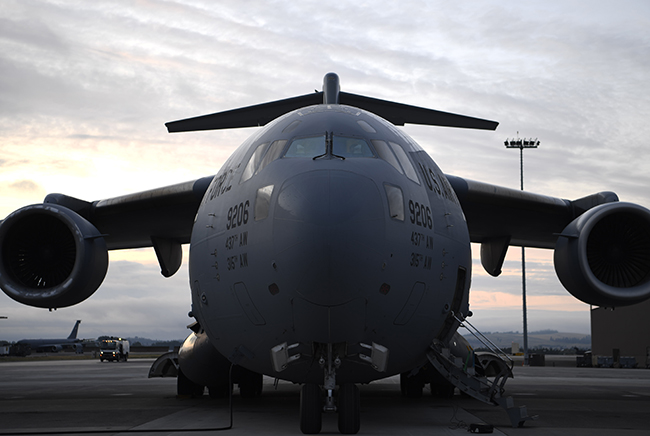
A USAF C-17 Globemaster III, assigned to JB Charleston, S.C., sits on the flight line on Sept. 17, 2019, at Fairchild AFB, Wash., in support of Mobility Guardian 2019. Air Force photo by SrA. Charles T. Fultz.
Air Mobility Command this year is flying 15 percent more sorties than it did about three years ago—albeit with about 570 fewer pilots than it needs and using a fleet nearly 40 percent smaller than at the beginning of the Gulf War.
To address that burden, the Air Force is trying to keep as many pilots as possible, modernizing its fleet, and relying more on Air National Guard and Reserve crews to meet its need, according to AMC boss Gen. Maryanne Miller. Still, the command is keeping an eye on future threats from potential adversaries like Russia and China that can “stress the ability to freely move forces at the time and place of our choosing,” she said Sept. 17 at AFA’s Air, Space & Cyber Conference.
The command flew about 28,000 missions in 2018, transporting approximately 929,000 passengers and delivering around 690 million pounds of cargo. Two simultaneous issues factor into the workload: One, wartime demand is steady, and two, AMC still needs to train for more complicated fights where Miller said the “size of the enemy, the particular theater, the threats, and technology have all evolved.”
Those drivers are exacerbated by the Air Force’s overall pilot shortage. The command has 36 percent fewer aircrews now than when the Gulf War kicked off in 1991, Miller said. The loss has slowed as the service starts to produce more pilots, and Miller estimates AMC will meet its pilot requirement in the 2025-2026 timeframe.
For now, however, “the stress is the tempo,” she said. The command needs to “build white space into their lives” so crews can spend more time at home.
“The quality of life is something we’re working on every single day, and we’re making strides,” she said.
The command continues to offer bonuses for pilots to stick around. In 2018, people accepted those bonuses about 38 percent of the time. So far this year, that rate sits at about 39 percent—meaning they convinced about two more people to stay, Miller said.
Miller said she’s started working the phones to understand quality-of-life issues. The four-star picks an officer at random, usually a lieutenant colonel or a colonel, and cold-calls them to ask how they’re doing.
“First, they tell me what they think I want to hear,” she said, before she stops them to ask truly “tell me what your needs are, tell me what your family needs. It helps me understand the force, all the force.”
Editor’s note: This story was updated to reflect the correct time span in the reduction of Air Mobility Command’s fleet and aircrews.